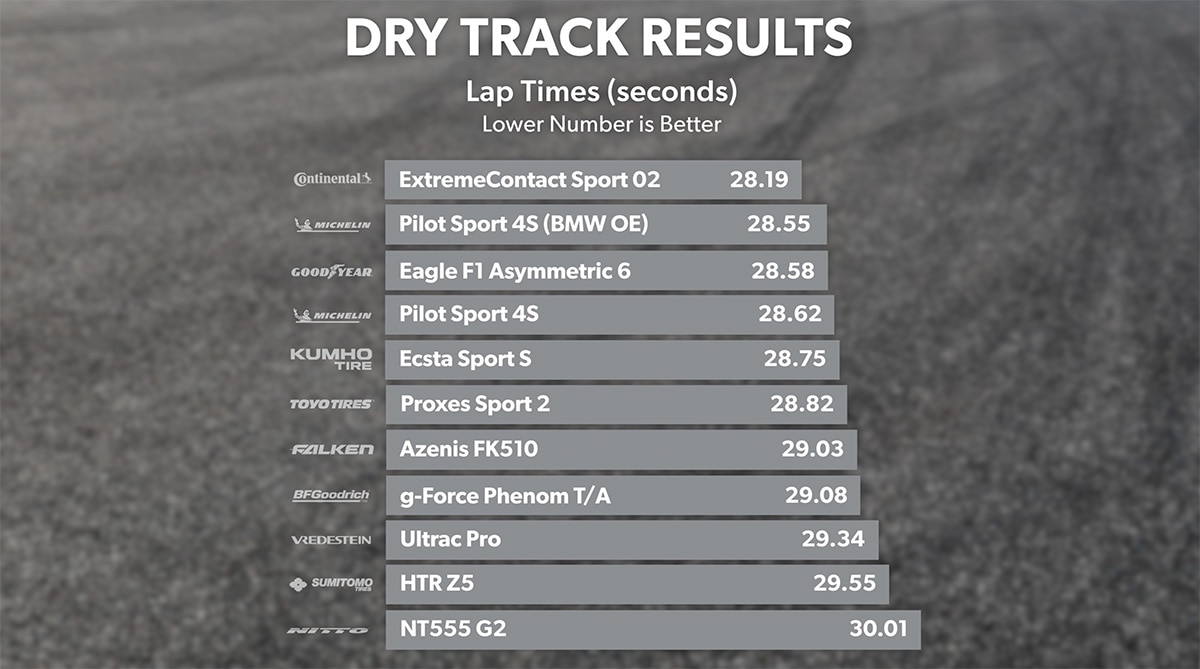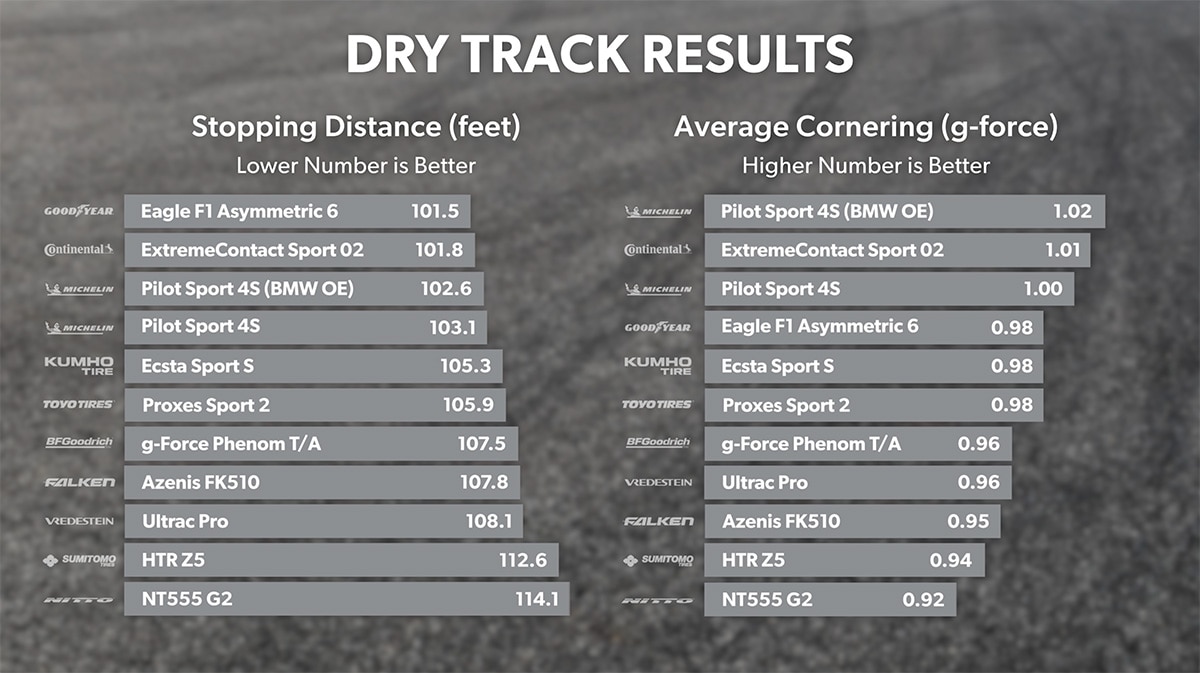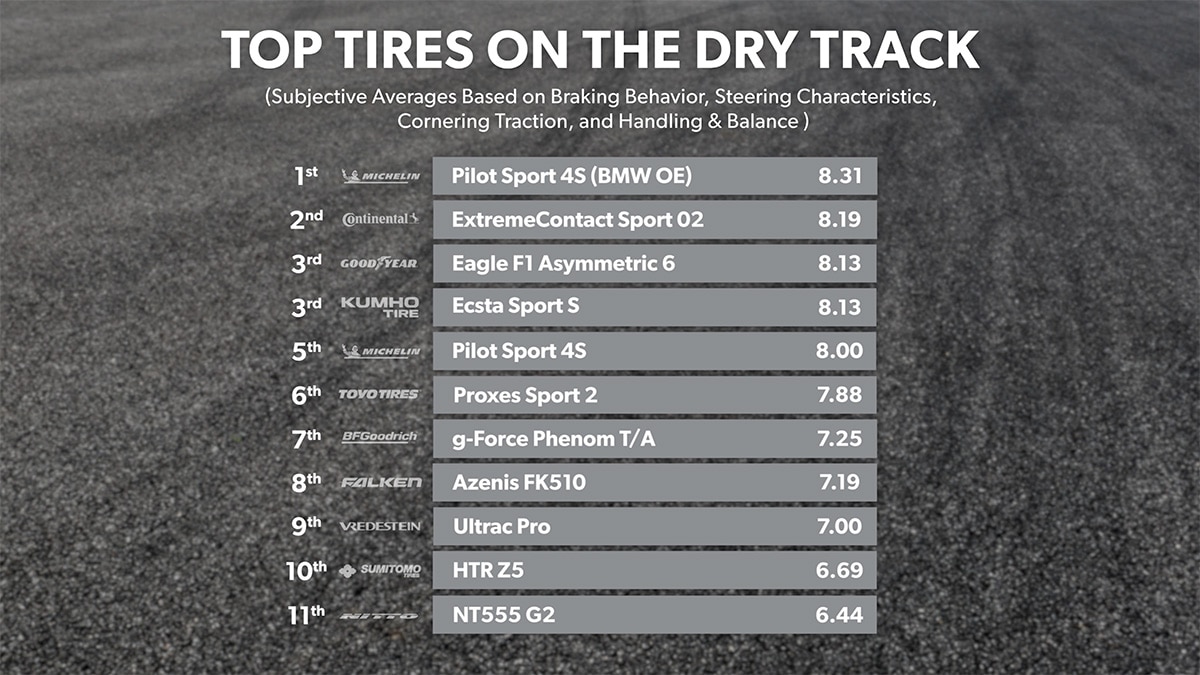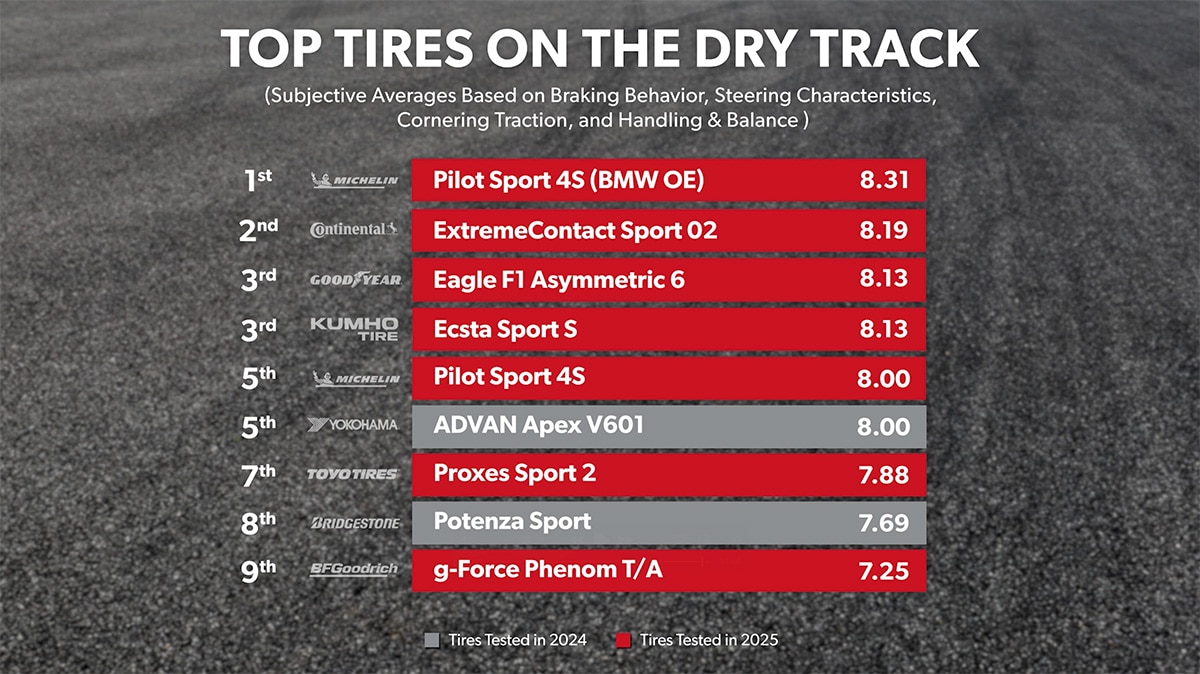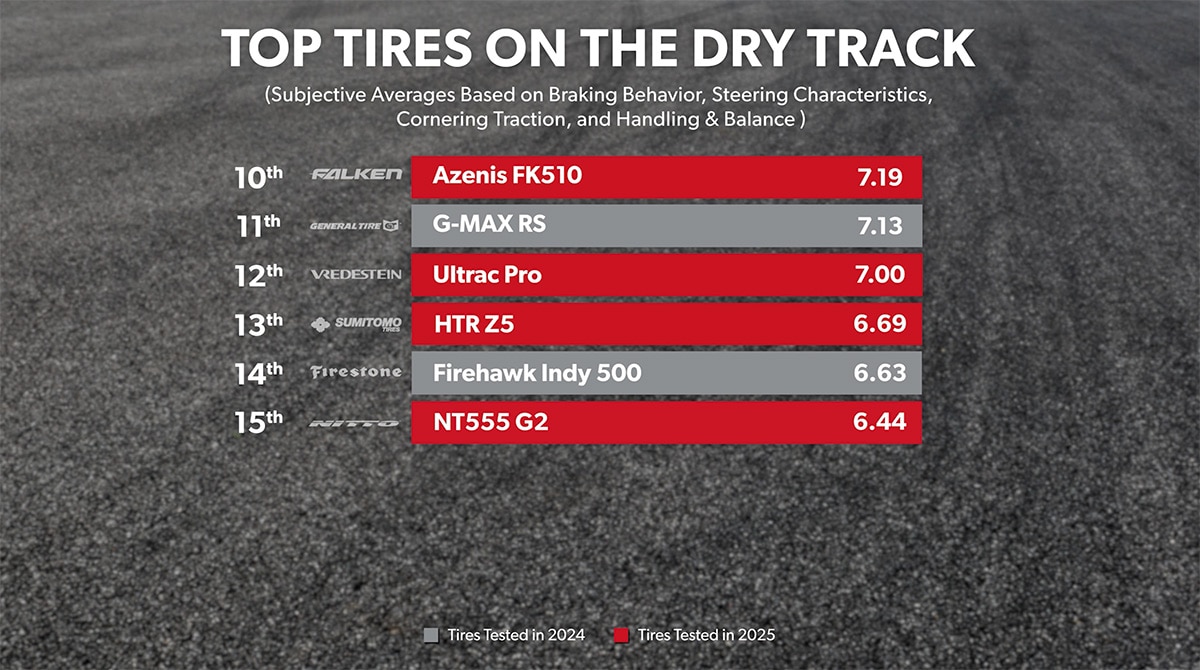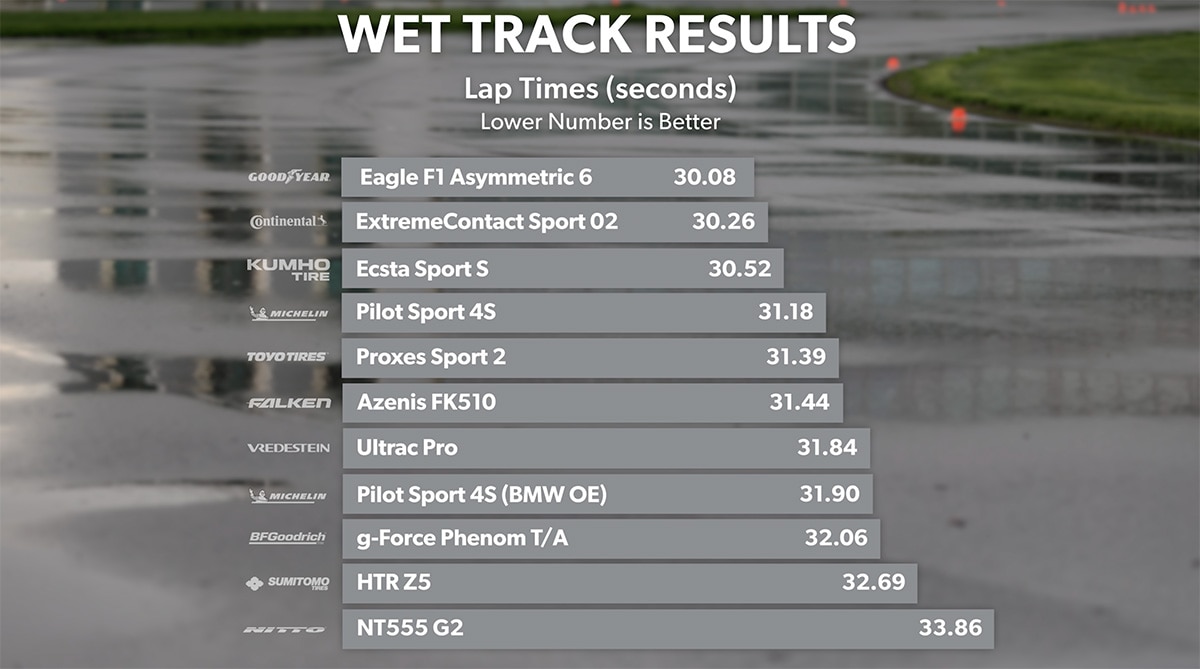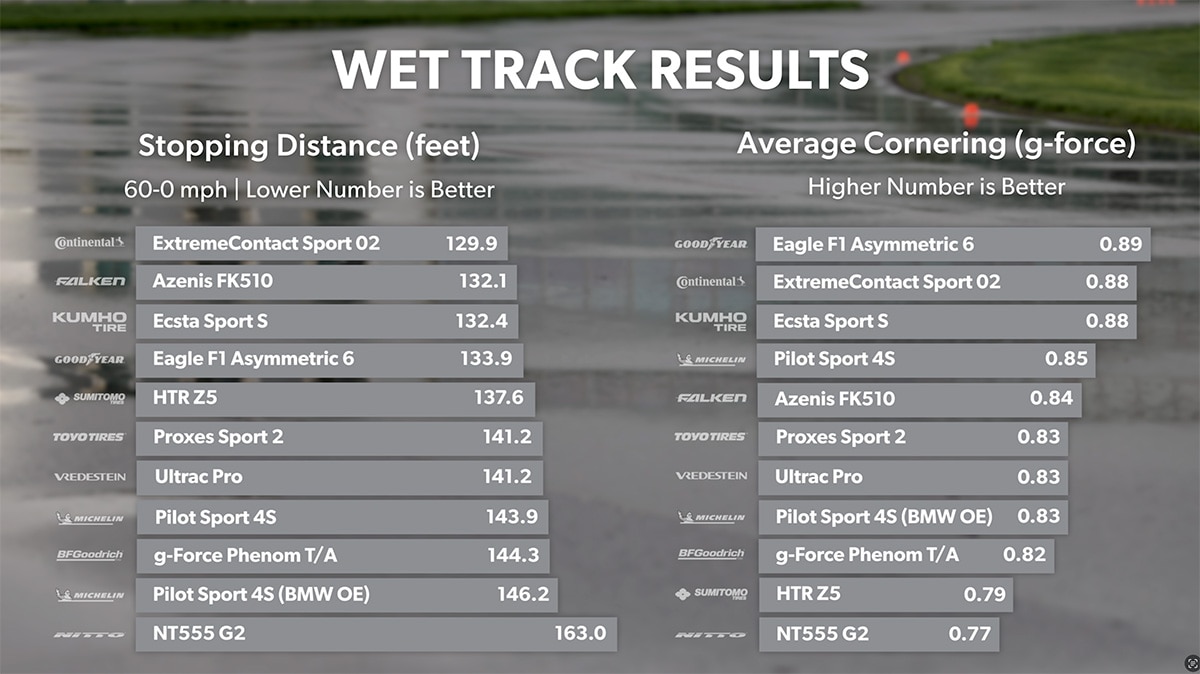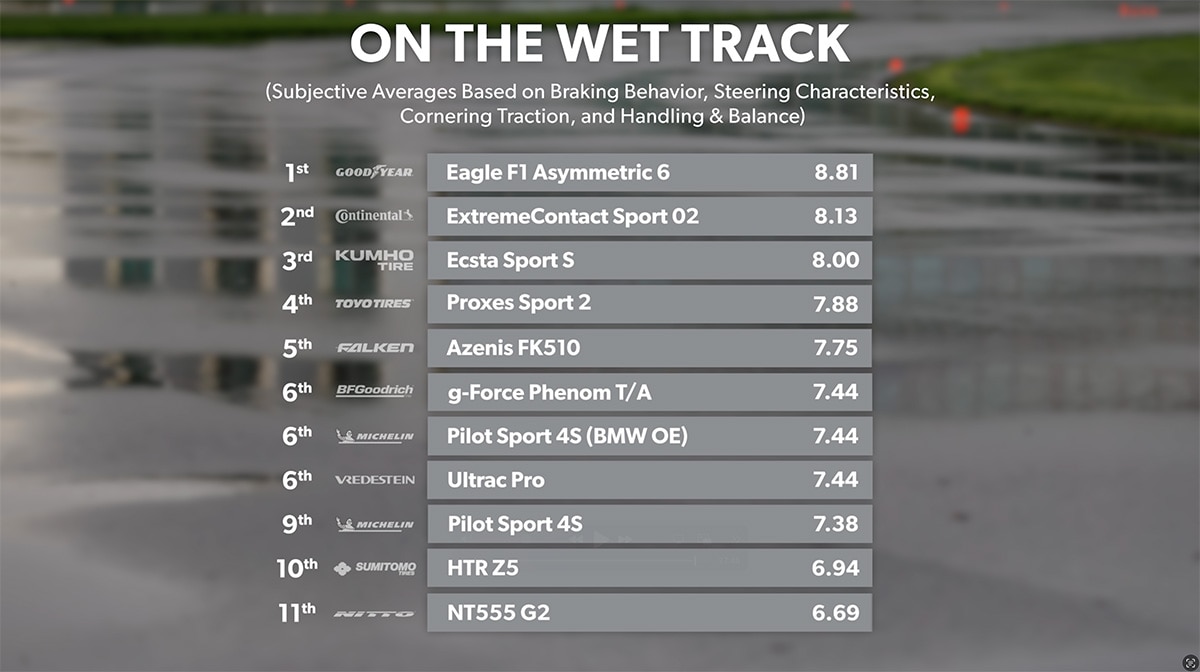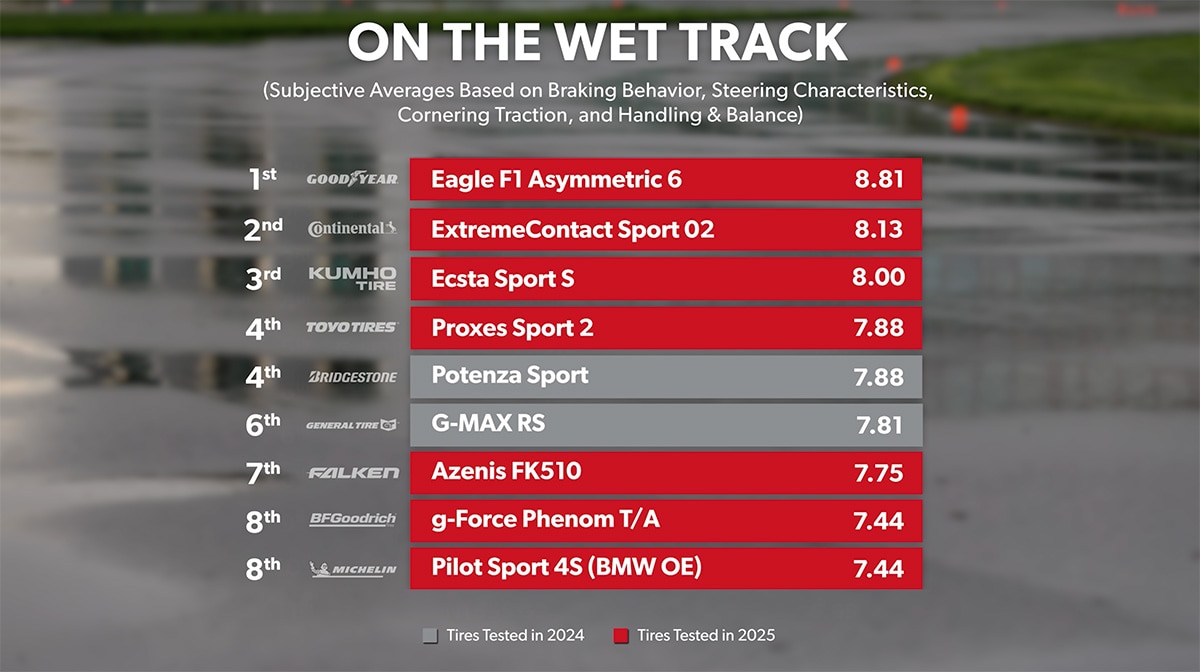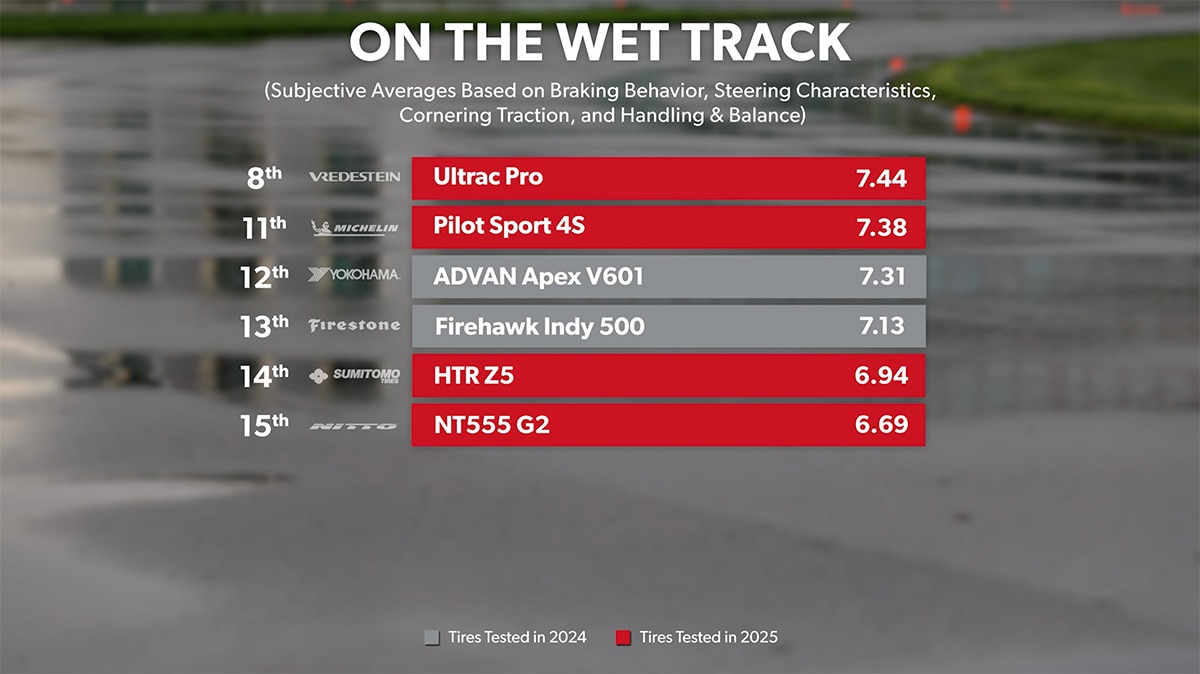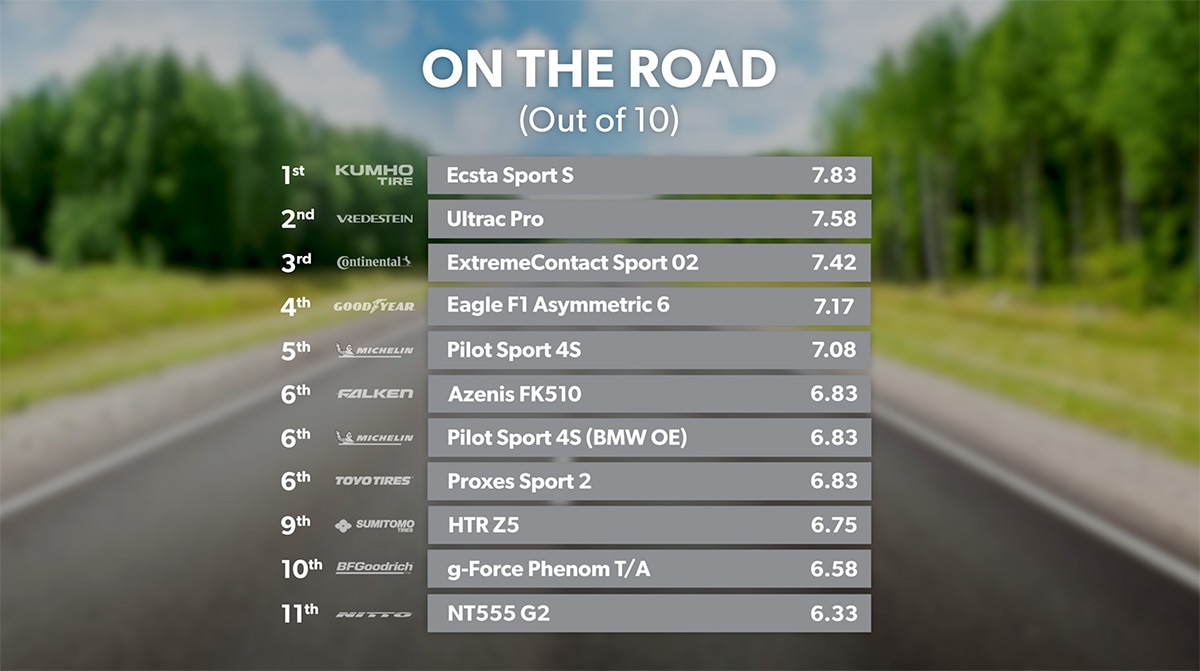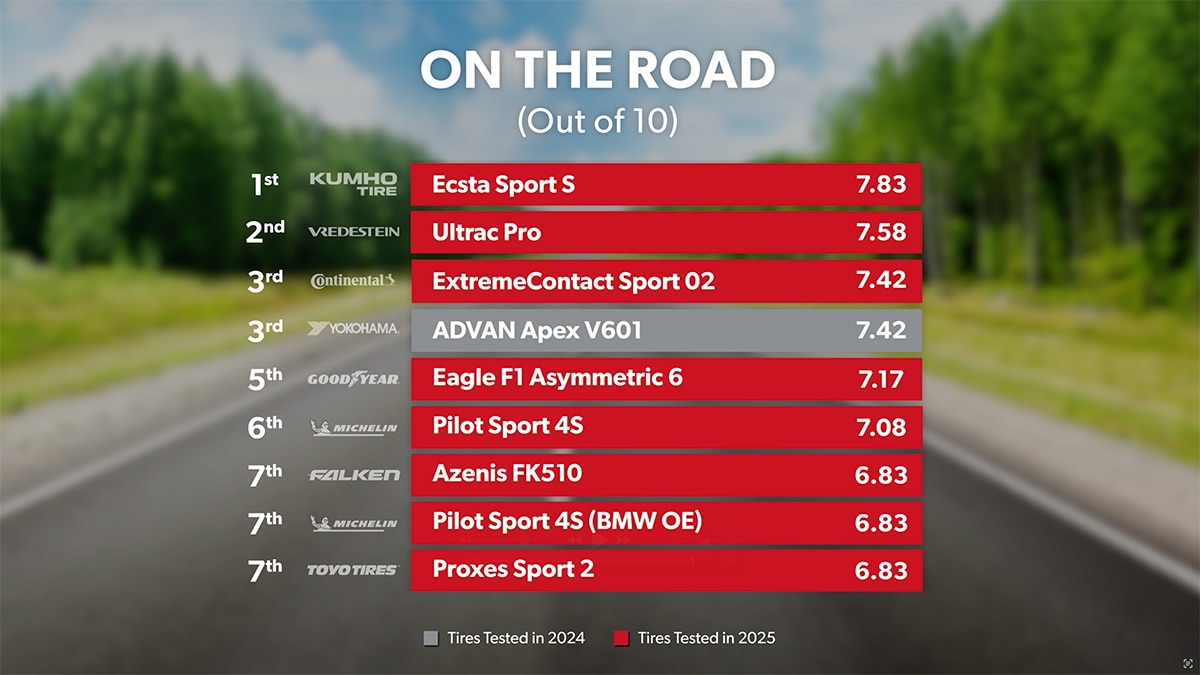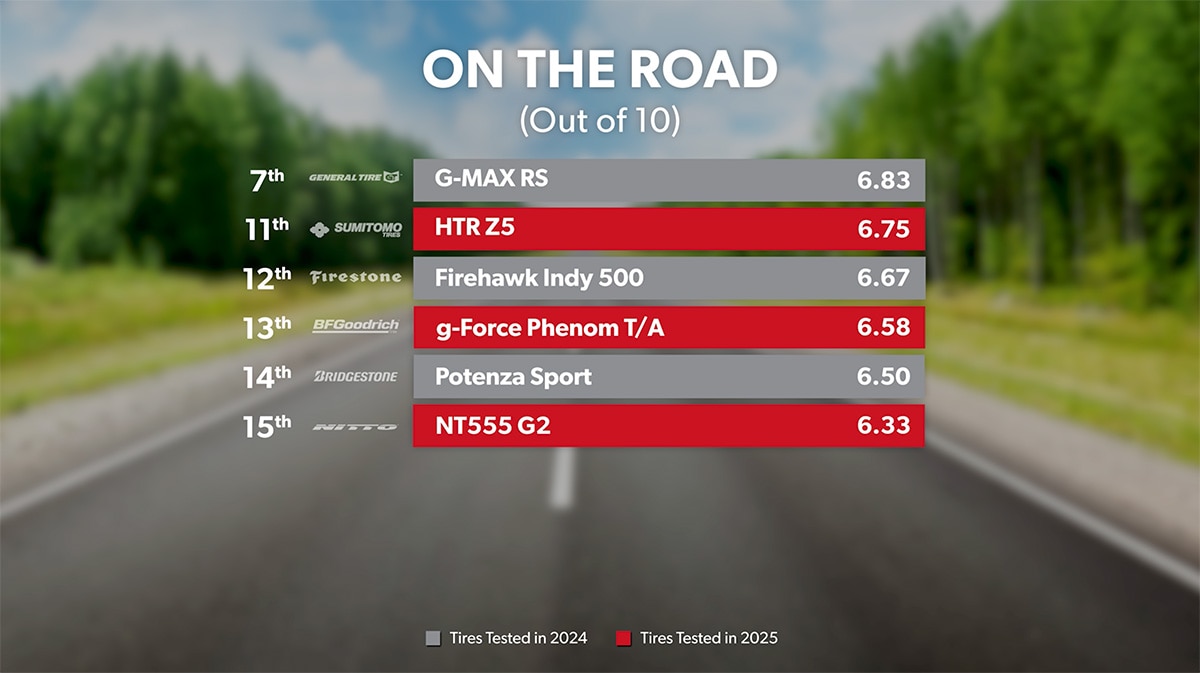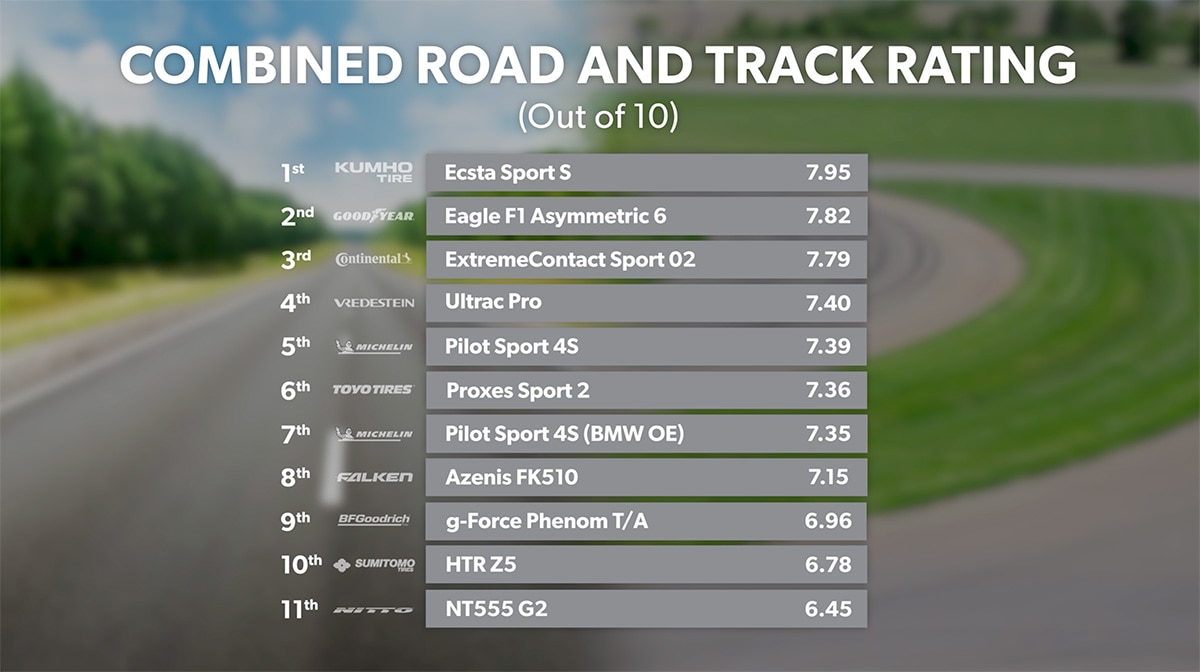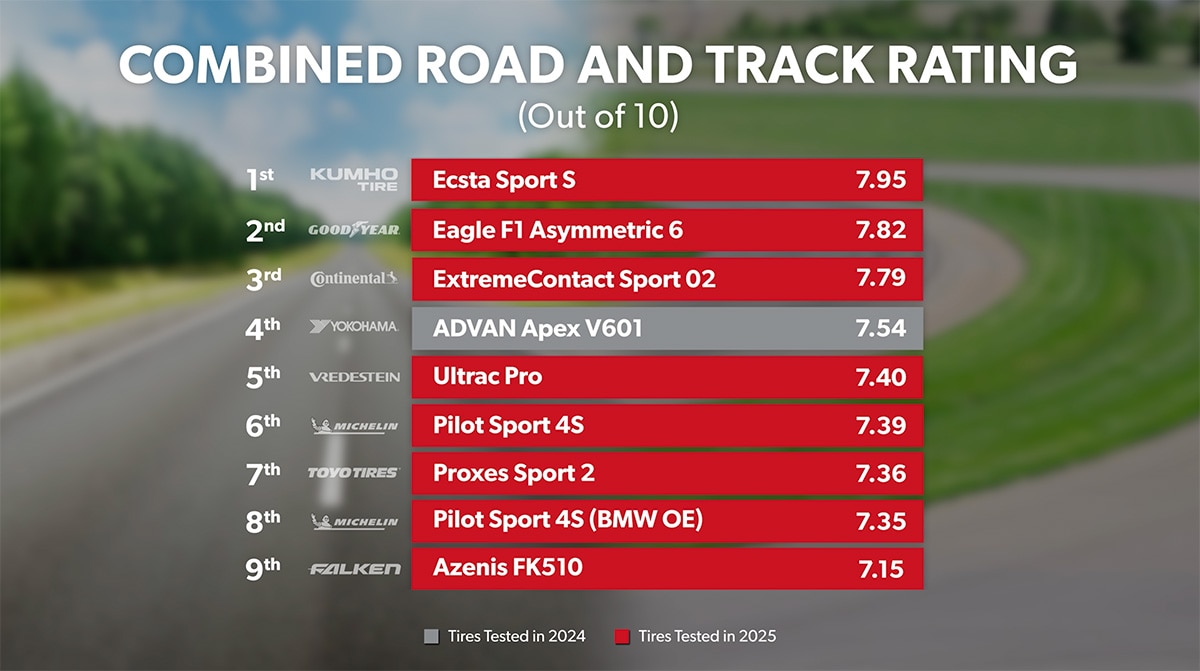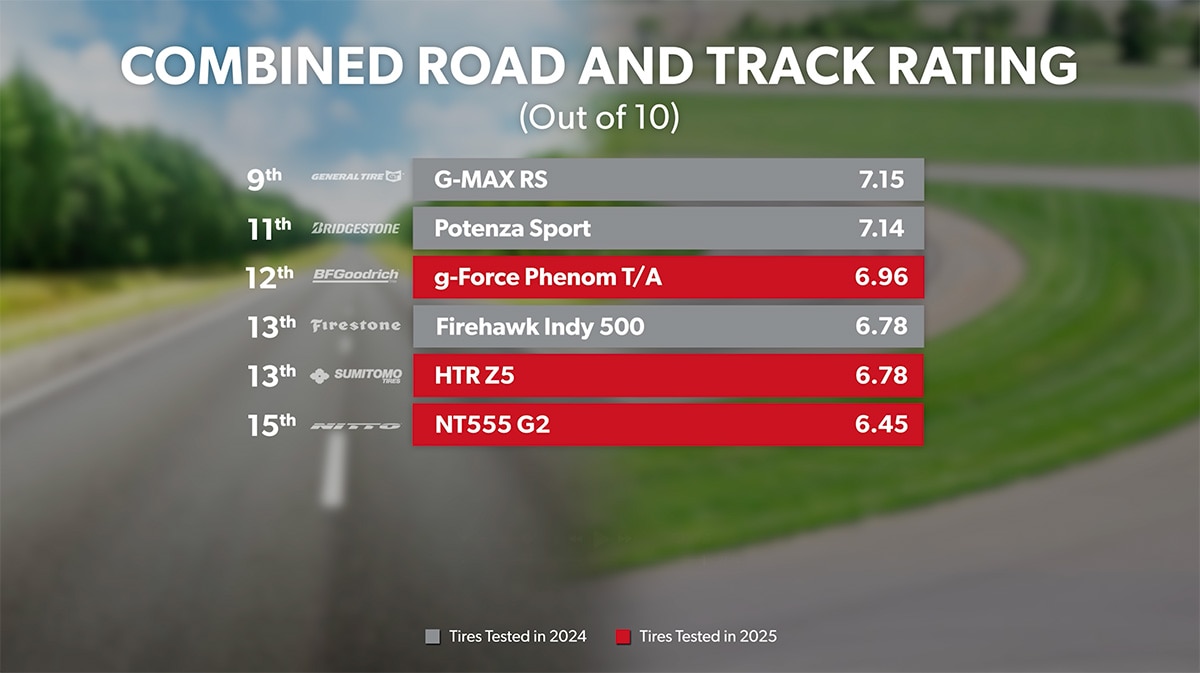The word "performance" serves many different purposes in the world of tires. It might be prefaced with all sorts of descriptors: wet, off-road, winter, track, high-speed, braking, etc. "Performance" - as a word on its own - only begins to tell the story of what a tire might be able to handle: so when we say we're looking at performance tires, it's important to define what that means in practice. Performance tires, without modifiers, prioritize enhanced handling response and wet/dry traction, improving the driving experience for all kinds of vehicles, everything from sedate daily drivers in need of a boost to high-power sports cars, hot hatches, and luxury vehicles.
The Ultra High Performance and Max Performance (both Summer only) categories we're evaluating today are where tire manufacturers put much of their most competitive R&D work. These are the kind of tires fitted to high-end vehicles with demanding power and speed, often driven by equally demanding customers expecting the best. They're tasked with operating at a high level in both the dry and wet - a serious ask on its own - while also remaining civil enough to be comfortable and quiet on the road, without giving up lively, reactive handling. Oh, and they shouldn't wear out too quickly, these are everyday tires after all, and need compounds capable of high grip and a reasonably long life.
So, where do they differ? In general terms, Ultra High Performance (UHP) tires have the same goals as Max Performance (MP) tires, they typically just do so at a lower level, or offer a greater value proposition. It's not a guarantee in either case: certainly there are cases where a UHP tire outpaces or outperforms an MP tire. There is always advancement, always newer products, aging products, the landscape shifts, and it makes testing them side-by-side interesting.
We'll introduce each, break down our experiences with them on our real-world road ride, then discuss their traction and subjective behavior on both a wet and dry track to understand how these tires act when pushed to their limits, mimicking the kind of high-speed emergency maneuvers you might need to deal with in a sudden crisis.
This report will start with Ultra High Performance tires as a group, then cover Max Performance tires, and finally discuss both in summary at its conclusion.
BFGoodrich g-Force Phenom T/A
One of the latest tires from BFG, the g-Force Phenom T/A represents a sort of spiritual return to their motorsports roots while also offering a value proposition for tuners and hot hatch drivers looking for an easy upgrade without breaking the bank. Ultimately, its success depends on bringing the kind of performance that can deliver on that ideal. On the road at least, it felt performance-tire stiff. We experienced the road's imperfections, but it remained composed, rounding off the bumps and impacts with only a bit of excess movement. Sound was reasonably well-managed, in that it avoided any major stand-out tones beyond cyclical noise over smooth surfaces. It wasn't quiet, but it wasn't annoying either. The handling was quick, and felt as if the response matched the input: you got out of it what you put into it. It did feel less planted at highway speeds and more eager to move.
When it came to running wet laps, the g-Force Phenom T/A delivered sharp, responsive steering and a lively front end that made it feel agile, athletic even. However, it struggled to fully back up that feeling with actual grip, particularly when it came to putting power down and holding steady at the limit. While it gave off the impression of being quick and fun, it lacked that touch of composure and traction found in stronger wet performers. It was eager to rotate, especially under trail braking or throttle. Good, but not great. Once the track dried off, the g-Force Phenom T/A once again made a good first impression. It felt strong during its initial laps, with gutsy power delivery and lateral traction, but as the tires heated up, it felt like there was a distinct fall-off in track adhesion. Control became more smeary, the tail felt eager to drift and it took effort to keep in check. It was still moderately quick, the 3rd fastest of the UHP tires, but it required precise effort to maximize it once heated up.

Falken Azenis FK510
Not a new tire to the segment, the Azenis FK510 has been on the market for a few years. It has tested well in the past for the UHP category, earning its place among the upper echelon of available options. The last time we took it for a test was all the way back in 2019 though, and it's due for a revisit. Our time with it on the road revealed an experience that holds up well for an everyday tire: delivering a comfort-oriented ride, doing a nice job of muting smaller bumps and undulations, though larger impacts still came through with some force. Road noise often produced multiple tones that, at times, blended well but were more commonly distinct and noticeable, especially on rougher surfaces. Steering felt a bit soft compared to others in the test; it was easy to manage but lacked just a bit of urgency.
The wet track felt immediately like a natural element for the Azenis FK510 - steering wasn't the fastest, but it was responsive, and perhaps more importantly: precise. It boasted the best 60-0 braking of the UHP tires, and was equally effective at putting down power when needed. It wasn't just about the strength of its traction, either laterally or longitudinally - but the harmonious delivery of it. Each distinct characteristic of the tire working in balance made it an easy tire to drive. It was an almost identical experience on the dry track: balanced, responsive, a tire that simply did what was asked of it and felt good to drive. Perhaps a bit more urgency in the steering would have helped, but it was the 2nd fastest UHP tire and, while still not competitive with the Max Performance tires, was one of the most pleasant to drive as a total experience.
Nitto NT555 G2
Another UHP tire that's been on the market for a few years, the NT555 G2 has garnered impressive customer surveys while waiting for its chance to make it into testing, and its time has come. The road portion of the test showed us a tire with a firm ride that handled impacts moderately well, a tad sharp over the larger hits, with extra movement over the smaller, but nothing that stood out as egregious. Noise was consistently present, but largely inoffensive, featuring a steady hum, occasional two-tone resonance, and vibrato on smoother pavement. Steering felt light and somewhat unrefined: it needed more input than expected at first, and then as it loaded up, needed less input and more adjustment which gave it a mildly sporty character, but one that felt unpolished.
The wet track didn't offer much more to help the NT555 G2 stand out from the crowd. It was limited in traction on the wet surface and that limitation was felt everywhere: it struggled to put power down, spinning fruitlessly without finding purchase on the surface, which made it simple to send the rear into yaw as well. It was easy to drift anywhere we liked, thanks to how controllable the tire was - the steering wasn't quick, but handled well. It was a similar drift-happy experience once the track dried off, with yaw in proportion to the size of steering inputs and throttle it was given. The lower traction limits meant keeping basic driving skills in mind first and foremost: combining braking and turning or mid-corner throttle would only create problems. It was the slowest tire around the track and had the longest braking distances in the test.
Sumitomo HTR Z5
Another category veteran, the HTR Z5 is the latest in Sumitomo's HTR Z line, and while it has been on the market a few years now, it's been a notable, if not exceptional entry. This was a good opportunity to retest a product that we last looked at back in 2019, a known quantity that serves as a comparative baseline to more modern offerings. On the road, the HTR Z5 was firm in line with expectations for the category, particularly over large impacts, with a bit more movement and texture over smaller surface imperfections. Noise levels were moderate, with low-frequency growl on coarse pavement and tonal variety on smoother sections, though it generally stayed composed. Steering was responsive and satisfying, with a small on-center dead spot followed by a confident, natural buildup.
During wet testing, the HTR Z5 felt quick and responsive, with steering that gave it a confident, athletic character and good overall balance. However, the available traction didn't quite live up to that promise; braking distances were longer than expected, and it was easy to overwhelm the rear on throttle. The result was a tire that felt eager and capable, but also introduced more missed braking moments or unexpected slides that cost time to recover. The dry track experience was the same song played again: lively steering let down by an overall limitation of available traction. It did not have a large window at the limit either; so the loss of traction, while not immediate, felt sudden. Largely as a result of its wanting grip and longer braking, the HTR Z5 was the 2nd slowest tire we tested around the dry track.
Toyo Proxes Sport 2
A brand new entry fresh from Toyo, the Proxes Sport 2 was built as a holistic improvement over its predecessor, and aims to improve over the previous tire in every metric. So, how does it stack up to the group? On the road, it provided a reasonable cushion against bumps and imperfections as long as they hit in isolation. However, anything repetitive, like tar strips, would string together, each minor impact running into the next. Noise was generally well-blended, but higher volume as a whole, with varied tones during smooth highway driving. The steering feel stood out as its most positive feature on the drive - just enough of a dead spot on-center to keep it from feeling overeager, but quick enough to feel reactive.
Once we moved over to the wet track for testing, the Proxes Sport 2 made an impressive appearance. The steering, which was already lively on the road, only complemented the M2's naturally quick reactions on the track. The front end authority was compliant, translating each input authoritatively into action. It required frequent corrections at the rear, with subtle but regular movement that made the Proxes Sport 2 a busy tire to manage. In spite of the need for constant inputs, it was rewarding to drive and maintained solid overall pace, with respectable lateral grip and braking performance. After the track dried, the Proxes Sport 2 exhibited a similarly well-implemented blend of balance, traction and reactive control. Power was applied well, it was clean and fast around the track - with lap times and braking distances ahead of all of the other UHP tires in the test.
Max Performance Summer tires are next, and by-and-large, represent the combined peak of dry/wet traction for the kinds of tires that drivers will want to drive on a regular basis.
Continental ExtremeContact Sport 02
One of the top-tier options available in the Max Performance category, the ExtremeContact Sport 02 has consistently tested well and remains a popular choice, it's a stellar tire to serve as a benchmark. This was proven true on the road with particularly nice compliance over impacts, large or small. At highway speeds we experienced slightly more undulation, but as a whole, the quality of the ride was well above most tires tested. Noise was handled well too, though less insulated against coarse textures and somewhat higher in volume, it was blended in a general "white noise" that wasn't obnoxious. Handling was light, responsive and joyful to direct. It has a very slight delay immediately off-center, which keeps it from feeling too excitable during straight-line highway driving, but moves through that quickly when asked.
The ExtremeContact Sport 02 was just as pleasing to drive on a wet surface, with powerful traction available everywhere, it felt more connected to the pavement, as if the water was barely a concern. It wasn't absolute - our drivers still needed to meter their inputs to handle larger maneuvers or hard corners, but the responsive steering and strong grip handled most small directional changes easily. It wasn't just subjective, either; objectively it had the strongest 60-0 wet braking in the test, and the 2nd fastest average wet lap times. Once the track dried off, it was just as spry, if not moreso. Handling was lively, pointing the nose of the M2 exactly where it was needed, with similarly authoritative braking. Traction was powerful, useful, and practically applied. It felt serious, professional, and composed, which reflected in its average lap times, boasting a comfortably fastest average overall around the dry track.
Goodyear Eagle F1 Asymmetric 6
Available in Europe for some time now, the Eagle F1 Asymmetric 6 is now arriving on our shores, riding a wave of positive reviews and feedback from across the pond - and we've been looking forward to seeing if this tire lives up to the hype. What we found on the road was a firm experience: it kept smaller impacts concise, large bumps were pronounced and translated to up-and-down motion in the cabin, but it never felt overly stiff or pointed. Hits did create impact ring, but noise as a whole was well-managed, blending tones on most surfaces into a broad, unintrusive whole. Steering was quick to respond without sacrificing accuracy. It felt natural to drive.
Once we brought it onto the wet track, it took almost no time at all for the Eagle F1 Asymmetric 6 to display its proficiency. The steering, which had already felt responsive on the street, was just as lively and precise, but more than that: felt appropriately mated to the tire's substantial traction in the slippery conditions. It transferred power with authority, and allowed our drivers to carry that speed through corners with ease thanks to its balanced nature. It was technically possible to overwhelm the available grip, but it was such a generous window that it never really felt on edge or difficult to manage. This was reflected in its test-leading average lap times. The Eagle F1 Asymmetric 6 wasn't quite as powerfully in the lead once the track dried off, though it remained one of the best tires we drove in the test, with correspondingly strong characteristics - only a touch more front end traction might have pushed it up a notch, but there was no denying it was very good.

Kumho Ecsta Sport S
One of Kumho's latest performance tires, and released alongside the Ecsta Sport and Ecsta Sport A/S (which we evaluated in our first test of the year) - the Ecsta Sport S represents the peak end of the performance trio. Its on-road experience was impressive all-around; the ride was more cushioned and composed than anything else we had driven in this test. Impacts were succinct without being sharp. Noise was little concern on most surfaces, with nothing significantly intrusive or annoying beyond low-notes from tar strips. Even the expected levels of tread interaction and resonance were lower volume than anything else we had driven during this test. Steering was linear, and appropriately responsive - walking the right balance between composed, on-center control and eager reactivity. Taken all together it was the nicest tire we drove on the road in this test.
The Ecsta Sport S was equally impressive in the wet, with that responsive steering carrying over nicely into more demanding driving. It was not immune to occasional understeer when pushed hard, especially in tighter corners, and didn't always put power down cleanly, but stayed composed and predictable. While it lacked the sharp authority of the very best in the test, it still offered confident, capable dynamics and was among the fastest tires we drove. It was a similar story once the track dried off, with sharp steering and a playful balance that made it engaging to drive. It felt a bit more on edge than some of the most planted options but still kept pace well, rewarding confident inputs without being punishing when pushed past the limit. While it lacked a touch of front-end authority, it remained easy to control and allowed for quick, composed driving.
Michelin Pilot Sport 4S
Perhaps more than any other tire in this test, the Pilot Sport 4S needs little introduction. It has been a popular tire and a longtime category stalwart that we've tested many times previously. This time however, it's included to fulfill a popular request: a comparison against its OE BMW version. The on-road experience was firm but composed, rounding over small bumps well, although larger impacts carried noticeable harshness. Noise levels were consistently elevated, and while not harsh, there was low-pitched hum and tonal variation across surfaces, especially on tar strips and smooth pavement. Steering felt accurate and natural, with a solid sense of heft, though a bit more immediacy off-center would have been nice.
The Pilot Sport 4S was certainly capable in wet conditions, with subjectively solid braking performance and quick responses during smaller directional changes. However, it demanded careful inputs to avoid front axle chattering understeer, and felt unpleasant, hard to make the most of what was otherwise decent grip. It just felt edgy at the limit, easy to go over, which made the experience a fight to get the most out of the tire, nor was it objectively fast enough to justify the effort, at 4th among the Max Performance tires in average lap times in the wet and 10+ feet further in braking distances from 60 mph compared to each one of the top 3. Once the track dried off, the Pilot Sport 4S was much more competitive: directing the front end with authority, braking promptly, and hanging in with strong lateral traction. Again though, if pushed to the limit, we experienced chattery understeer that hurt its handling feel. Steering still felt good, but particularly as it heated up, felt let down somewhat by the limitations of its grip.

Michelin Pilot Sport 4S (BMW OE)
This is the Original Equipment version of the Pilot Sport 4S specific to the BMW M2. The precise changes between aftermarket and OE versions of tires are rarely made public, and covering all the ways in which they might differ is outside the spectrum of this report - but in brief, OE tires are typically fine-tuned in ways specific to the model of vehicle they're intended exclusively to be used for. So, we're driving both versions of the Pilot Sport 4S to compare and contrast the two.
Straight away on the road we began noticing differences: the OE tire felt more taut in every way, stiffer over impacts big and small, with considerable harshness over the larger ones. Noise was also remarkably more present from most sources: impacts, tar strips, concrete, resonance at highway speeds. It didn't seem to be coming from any greater amount of tread interaction, as smooth surfaces were roughly equal to its non-OE kin, but felt like it was a result of being more tightly wound. On the other side, its steering response felt like a comparative step up - quicker, more alert, more immediate.
In the wet, compared to the replacement version, this tire delivered sharper, more precise steering and better front-end responsiveness, allowing for more confident placement and less reliance on high entry speeds to maintain pace. It still exhibited front-end chatter when pushed, but was generally easier to keep just below that threshold. The rear remained active, particularly around tight radius corners like the 180, but once we got a handle on the balance, it proved effective and engaging to drive even if it was slower than its non-OE counterpart in lap times. With a dry track, the OE Pilot Sport 4S needed time to heat up, but once it did, what we found was a nicer experience to the non-OE tire. It felt sharper, more athletic, and eager to work with the driver in whatever they wanted to do. Objectively, braking was a foot better, though in practice both tires felt on par there. Both displayed edginess at the limit, though the OE felt stronger laterally. They were very close in most respects, but the OE posted faster average lap times (28.55 vs 28.62) as well.

Vredestein Ultrac Pro
Vredestein's latest Max Performance Summer tire, the Ultrac Pro was envisioned as a more comfort-focused entry to the category, and while we briefly included it as part of last year's performance category comparison, we're happy to circle back to this one for a full test evaluation. Our impressions on the road were that, in terms of fulfilling the "comfort" part of its goals, it was mostly on-point. It was reasonably firm, but composed, rounding off most of the sharpness found in other tires. Smaller bumps were handled well, but repetitive imperfections could have been more concise. They felt as if they built on one another, not fully finishing the movement before beginning the next, a characteristic that felt unique to the Ultrac Pro. Noise levels were well managed across all surfaces, and the steering felt responsive, precise, and naturally weighted, offering good communication without feeling twitchy.
During wet testing, the Ultrac Pro delivered solid steering precision with a firm return to center and generally predictable behavior, but it lacked the overall grip needed to feel competitive with the top options. Front-end authority was limited, and once traction broke away, the response felt soft and somewhat unresponsive. While it was friendly to drive and subjectively agreeable, its performance ceiling fell within the lower tier of the category for this test. After the track dried off, the Ultrac Pro showed off decent steering precision and a generally well-mannered balance, but again, it lacked the grip needed to keep pace with the top-tier. It understeered easily with aggressive inputs, and while rotation was possible under trail braking or throttle, it came at lower limits than expected. It was friendly and controllable but slower than the other tires tested.
Summary Conclusion
It's no secret that Max Performance tires were generally going to outclass their Ultra High Performance counterparts, and with little variation, that's largely what we saw in this round of testing. However, there were a few notable standouts and shake-ups among the top tires in the test, and very competitive UHP tires that did an excellent job blurring the lines between categories at this level.
First off though, the Kumho Ecsta Sport S has absolutely earned its place at the top of this test for just being a stellar all-around tire. It was easily the nicest we drove on the road, which makes it a no-brainer for a daily driver, but it also backs that up with impressively well-balanced performance in the wet and dry. Goodyear's Eagle F1 Asymmetric 6 and Continental's ExtremeContact Sport 02 deserve near equal billing alongside it, with both actually outperforming it slightly in the wet or dry, while still being pleasant to ride on outside of more aggressive circumstances. It's very common to see a tire excel in one realm or the other at the expense of its other attributes, and all three of these tires managed that tight-rope balancing act very well.
Vredestein's Ultrac Pro is an interesting example compared to the above tires, as it was designed specifically to cater to the on-road experience, and does that well, albeit at the expense of its overall traction ceiling, to the point it was actually outpaced by a couple of the UHP products. Michelin's Pilot Sport 4S remains a respectable force in its category, and deservedly so - but much of its competition has caught up to the venerable icon. On that note, Toyo's Proxes Sport 2 is a terrific example of how advancement in the competitive landscape and tire technology has produced a UHP tire that challenges the expectations of category lines, moving the bar forward for both categories at the top and bottom. The BMW OE variant of Michelin's Pilot Sport 4S was a notable addition to this test, not just because it satisfied the curiosities of those comparing aftermarket to OE, but as an example of a tire so strongly dedicated to the dry experience that it does fall off a bit when compared head-to-head in other respects.
Of the rest of the UHP tires, Falken's Azenis FK510 deserves particular note for being, while not one of the strongest performers out here, a balanced, pleasant tire to drive while maintaining good performance chops. The scores and objective numbers don't always tell the whole story for how a tire feels subjectively, and this was a classic example of that. BFGoodrich's g-Force Phenom T/A is a new product squarely aimed at being a good entry level option for drivers who want a set of tires that will improve performance while keeping value in mind and, in that they've succeeded. It's not going to set the world on fire, but it was never positioned to. Finally, Sumitomo's HTR Z5 and Nitto's NT555 G2 are similar, at least in that they're both fine tires in their own respects, but operating at lower traction ceilings in comparison to the best and brightest on offer here.

